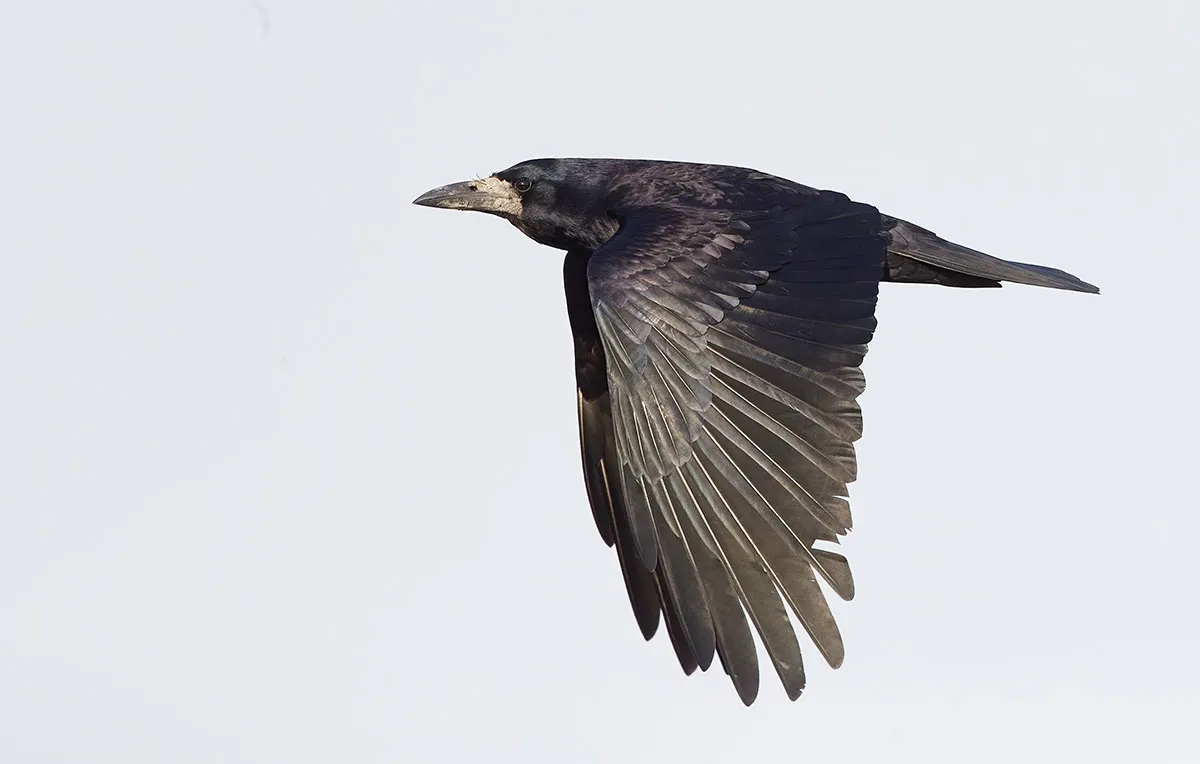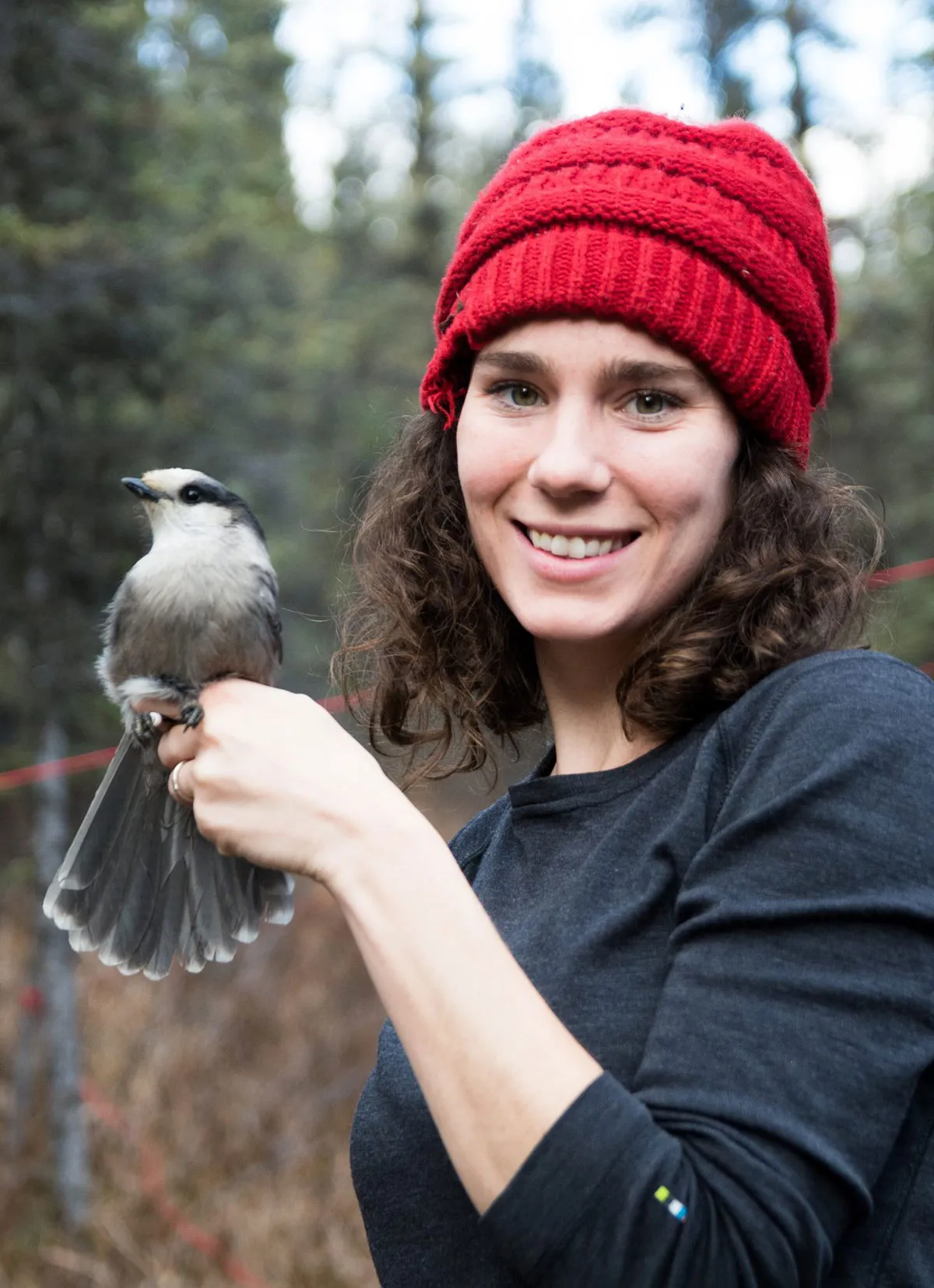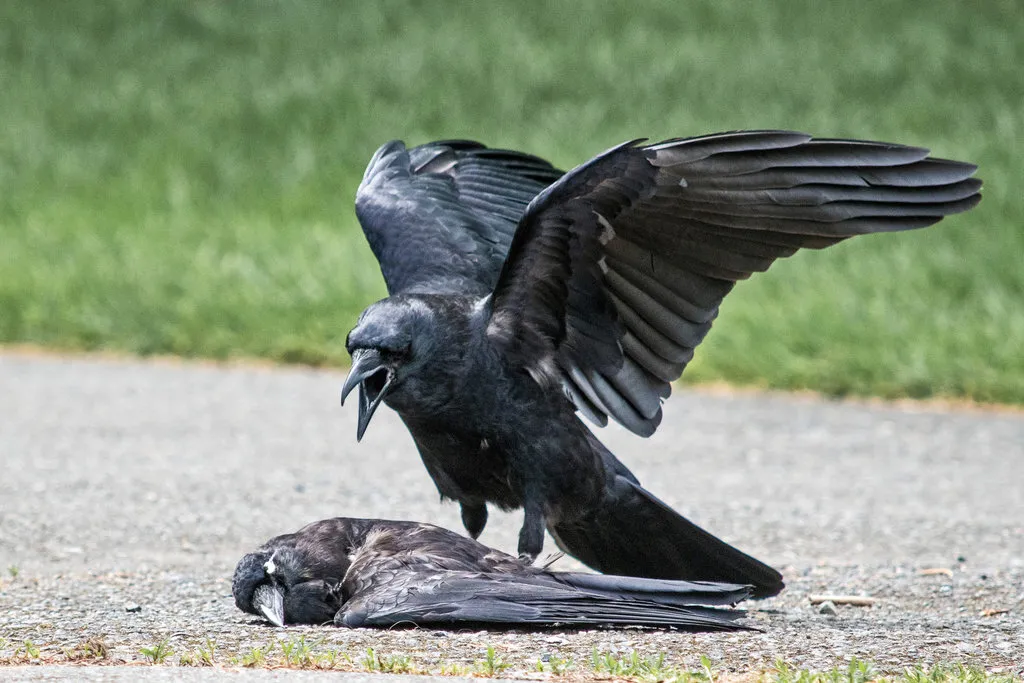Corvids, such as crows, rooks and ravens, are some of the smartest animals out there. They can learn to make new sounds, they can cooperate and even use tools. But as Dr Kaeli Swift tells Alice Lipscombe-Southwell, they also have some intriguing rituals when it comes to their dead… and could even be capable of feeling empathy.
What exactly is a corvid?
Corvids are a kind of songbird. Corvids, so the Corvidae family, includes crows, ravens, magpies, jays, rooks, jackdaws and choughs. Ravens are the biggest songbird in the world.
They’re songbirds? But a crow makes a ‘caw caw caw’ noise, which sounds pretty different from other birds.
‘Songbird’ is a little bit of a tricky name because the designation of songbird is based on both the positioning of the feet and, most importantly, the anatomy of the vocal area. And that’s the feature that these birds share with birds like robins and sparrows and all that kind of thing.
Humans produce the sounds that we do using a larynx, and most birds, including songbirds, have what’s called a syrinx. The anatomy does differ a little bit across groups, but the corvid syrinx is going to look pretty similar to other kinds of songbirds. The main difference, though, between crows and ravens and other types of songbirds has less to do with their anatomy and more to do with their brain.
Most songbirds have a short window of time when they’re young where they learn every sound that they’re going to make, then that window closes, and that’s it. They don’t make any changes moving forward.
But one of the really interesting aspects about crows and ravens is that they can learn new sounds throughout their lives. They have really, really impressive vocal repertoires. Part of the reason that they can make such a wide variety of sounds, including human speech, is because they have independent muscle control on either side of their syrinx, so they can produce two different sounds at the same time.
Read more about crows and ravens:
- Four-month-old ravens could be as intelligent as adult apes
- Do crows actually fly in a straight line?
- Crows remember threatening faces
In the UK, some of our most common corvids are crows, rooks and ravens, but people quite often get these confused. Is there a way you can easily tell them apart?
It takes practice, but there are definite tools that you can accumulate and you can get really good at it. The first thing is ravens are quite a bit bigger than crows. The second feature is if you look at the throat, ravens have these really kind of rough, heavily textured throat feathers, whereas the throat of a crow is smoother. And then the last feature is the shape of the tail. When ravens fly they have this kind of wedge-shaped tail, whereas crows have a more c-shaped, rounded tail.
Rooks are really easy to distinguish once they’ve had their first adult moult, as they lose all of the feathers at the base of their beak. We don’t quite know why this happens, but it could be because rooks are incredibly insectivorous, and so they probe in the grass a lot for bugs. The lack of feathers might be a hygiene thing.

How intelligent are corvids?
Corvids are incredibly smart. One might make the argument that primates are really about as smart as a crow!
One of the challenges to studying intelligence is making sure that your tests make sense and are executable by the animal in question. There are tests that we give to chimpanzees to evaluate their intelligence that we simply can’t give to a raven because they can’t participate in it as they don’t have hands.
There are a variety of categories – like analytical skills, ability to understand quantities, problem-solving skills, ability to understand cause and effect, ability to cooperate or pick up on social cues – that reflect intelligence on a pretty high cognitive level.
We’ve been able to demonstrate that in humans and primates, but more and more we’ve been able to design those kinds of tests that are appropriate for crows and ravens. And we see that the performance is often quite similar to what we see in primates.
What about tool use?
New Caledonian crows make a variety of tools, most impressively hooks. There’s a plant that’s native to the area where the crows live, called the pandanus, which is really rigid with a serrated edge. The birds will peel off sections of the edge of this plant and then whittle it down to the appropriate size and stick it into the crevices of logs and rotting wood to pull out grubs, in a similar way to how chimpanzees will take twigs and then modify them so that they can extract ants.
Beyond that, they’ll also snap off branches and modify them in ways that the resulting tool meets the minimum definition of a hook, which is incredibly impressive. Tool use is rare in the animal kingdom, only about 1 per cent of the animals use them. But making tools, actually taking objects and modifying them, is much more rare. Other than crows, we recently found this in a parrot and then a couple of primates.
Speaking of behaviour, you studied death rituals in corvids. Tell us more.
For a long time, humans have recognised that these birds respond strongly when one of them dies. And you can see that evidenced in religious text and mythologies. For example, there’s a story in the Qur’an about ravens teaching Cain to bury his brother Abel, because they understood that that’s what you did when somebody died.
The way that this strong response manifests in crows is that when a crow dies and is discovered by another, that crow will make an alarm call and it will draw in other crows in the area. They all get together in this big, raucous mob and take notice of this event. And then after about 15 or 20 minutes or so, the group disperses.
If these animals are engaging in this behaviour, it’s something that they have done for tens of thousands of years. There’s a reason. And so what is it? Do they engage in these ‘funerals’ as a way to learn about danger? Some reasons may be just as valid, like are they grieving, but they’re not testable.

Does any old dead crow cause this effect? Or does it have to be a crow that they are familiar with?
We exclusively tested unfamiliar birds, so it’s still an open question of how their behaviour might be different if it’s a bird they know. Certainly, it would make sense given how closely these birds pair bond, how long that relationship can be, that the behaviour might actually look a little bit different if it’s their mate of over a decade that had passed rather than some random crow. But that’s not something that I looked at.
You said they see the dead crow as maybe a learning opportunity. But did they ever do anything else? Did they see the dead crow as a food source and try and peck at it?
That was one of the questions that I tested later on as a graduate student. We had started feeding the crows over the course of several days, and then we exposed them to a person paired with a dead crow. We found that in the following three days they were more wary to come to that pile of food, and they learnt people were associated with dead crows.
So if they saw somebody they’d never seen before holding a dead crow, and then they saw that person again in the future without the dead crow, they would treat them like a predator. So clearly they’re making some kind of connection between danger and dead crows.
If it’s about danger, then we would expect them to respond more strongly to dead adults because adult survivorship is much higher than it is for juveniles. Juvenile survivorship for that first year is only about 50 per cent, but for a prime-of-life adult it can be as high as 80 per cent. It’s not unusual for crows to live for 14 to 17 years.
To study this, we didn’t put out dead crows paired with predators, we just put dead crows out on the sidewalk. And so I’m doing one of those experiments, kind of not thinking much of it. And suddenly the crows are doing something I hadn’t ever seen them do in that first round, which is coming down and actually interacting with the body. And so that spun off into an entirely different study.
We found that any kind of contact between crows and dead crows happens somewhere between 30 and 40 per cent of the time. And that contact can be very variable. Sometimes it was a curious ‘sneak and peck’, where they just kind of prod it like a kid might if they saw a dead bear in the woods.
It could also be incredibly aggressive. They come and really tear these birds to pieces. It didn’t seem to be in pursuit of food, but they would just come and really want to make sure that they were dead.
And then in a minority of cases, about 4 per cent of the time, we found that the behaviours could actually be sexual. So we saw copulatory attempts between living crows and dead crows, and even two instances of a mated pair coming down and simultaneously mating with this dead crow and each other. So it got it got surprising, to say the least!

Surely hasn’t been recorded in many other species, has it? That’s just nuts!
So here’s the rub. Actually, it has been recorded in most animals that have really robust responses to their dead, like elephants, primates, whales, dolphins. We see all three of those behaviours manifest. So the kind of curiosity-based behaviours, aggressive behaviours and sexual behaviours.
And in fact, dolphins are way more prone to that than crows are. I had the exact same reaction the first time I saw it. I thought, “Oh my gosh, what is happening here?” And then I looked in the literature and I was like, “Oh, this really is a thing among these social, intelligent animals.” There seems to be this very variable way that they respond to their dead. It is being represented over and over again.
Do these rituals suggest the birds are feeling any sort of empathy for each other?
That’s a tricky question. One of the things we did was a neural-imaging study where we took wild crows and brought them temporarily into captivity. And we have this really cool non-lethal imaging technique where we could take an awake crow and show it a dead crow and then anaesthetise it. We put it in a scanner and use a chemical to track their brain activity from earlier when they were awake and looking at a dead crow. And then the crows come out of the scanner, they wake up and then we let them go.
We wanted to get at the question of how they were feeling about the dead crow. We thought that by looking at the brain, it might give us a bit more insight. The avian brain and the mammalian brain are quite different in a lot of ways, but in other ways, they are similar. They have parts that do basically the same thing, including the amygdala, which is the emotional centre of the brain.
We wanted to see if the amygdala lit up when they saw dead crows. And we found that it did not. The area that lights up is analogous to our prefrontal cortex, which is the decision-making, thinking part of our brains. This aligns quite well with what we saw in our other field studies where crows are using these experiences as indications of danger and making all kinds of decisions based on that information. Now again, like I mentioned before, we were showing them unfamiliar crows, so would their amygdala light up if they saw their dead mate? I can’t answer that.
However, if we put all of that aside and say that those particular studies may not be able to get at that question, we have done other studies that were specifically designed to evaluate empathy. These have shown some really promising indications that yes, in fact, these birds may well possess empathy.

The way we’ve done those studies is to look at what’s called ‘emotion contagion’. Contagion is basically the idea that if your friend is sad and you’re like, “Hey, what’s up?” And they’re like, “I’m really sad.” And then you say, “Oh no, now I’m sad, too!” That is empathy, right? It’s taking on the emotions of another.
We’ve been able to show that ravens are capable of something that looks exactly like that. There was this cool little study where they have two chambers where you had a demonstrator raven and an observer raven. They couldn’t interact with one another, but they could see each other. The demonstrator raven is given a box and it can look inside that box. The observing raven can’t see what’s in there. It can only see how the demonstrator reacts to it.
In half the cases, the demonstrator was given something really cool, something delicious. They got very excited about it. And in the other half of the trials, they were given something boring. They look in the box and they’re like, “I don’t care about this.” And the observer watches that.
Then the researchers would give the observer raven a box, and they found that observers that had seen a demonstrator get really excited about what was in their box were like, “Oh, let me at this! I’m going to look in this box. I’m so excited!” And in the other group, they’re like, “I don’t want to go near that box. I don’t know what’s in there. I don’t care, get it away from me.”
And that is emotion contagion. That is looking at someone’s reaction and feeling the same way as them too. So I wouldn’t use my studies as a way to get at whether or not these birds possess empathy, but there are folks who are pursuing that, and there does seem to be evidence that they very well could.
- This article first appeared inissue 375ofBBC Science Focus Magazine–find out how to subscribe here
About our expert, Dr Kaeli Swift
Dr Kaeli Swift is a bird researcher at the University of Washington. She did her PhD on crow death behaviours. She runs the weekly #CrowOrNo challenge on Instagram, Facebook and Twitter.



